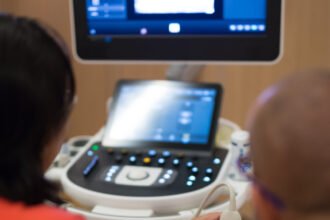Rupture of the amniotic sack is a normal part of delivery, but when the membranes rupture before the baby is due, both the mother and the infant are at risk. Small ruptures aren?t always immediately obvious to either the mother or her healthcare provider. That is why it is so important to detect pre-ruptured membranes as quickly as possible. How can healthcare providers help detect these membrane ruptures early? Talk to the Patient Your patient will be the first person to tell you something is wrong with her pregnancy ? even if there isn?t anything wrong. Your patient might complain of:
- Constantly feeling like she?s urinating herself
- More wetness than normal
- Bleeding
- Excessive pelvic pressure
If that?s the case, checking for pre-ruptured membranes should be the first thing on your agenda. Most of these tests are non-invasive and can be completed with little to no discomfort. Traditional Testing Methods There are a number of methods to determine if a patient?s membranes have ruptured prematurely if leaking amniotic fluid is not an obvious symptom: 1. pH Testing ? A sample of fluid from the vaginal canal is tested on a pH strip. Normal pH should be between 4.5 and 6.0. Anything higher could indicate membrane rupture. Amniotic fluid registers at 7.1-7.3 pH. 2. Nitrazine Test ? This is similar to the pH test, but it is designed to specifically test for the presence of amniotic fluid. If a sample of fluid is placed on the strip, it will turn blue. 3. Ferning ? Amniotic fluid creates a unique pattern when observed under a microscope, due to the salt in the fluid itself. 4. Ultrasound ? If the fluid levels are significantly lower than normal, this can be determined with an ultrasound. Unfortunately, this does not offer an explanation for the low fluid level ? this could also indicate problems with the fetus? kidneys or urinary tract, or problems with the mother such as dehydration, preeclampsia or diabetes. Membrane rupture can also be detected by injecting a non-toxic dye into the amniotic sac. If the membrane has ruptured, the dye will be detected in the vaginal discharge within about 30 minutes. The dye injection presents its own risks, however, especially if you suspect that the membranes have a small tear or rupture in them. A New ROM Test While previous testing techniques for premature membrane rupture offer moderately accurate results, they require a speculum exam that can be extremely uncomfortable for women late in pregnancy. Additionally, these tests don?t offer a definitive answer ? upwards of 47% of professionals in the field report that they are unsure of the accuracy of their membrane rupture diagnosis. Newer tests designed to detect membrane rupture are much less invasive and only requires a non-invasive vaginal swab to detect membrane rupture. This sample is then mixed with a vial of proprietary liquid and placed on a test strip. It is very similar to traditional PH and nitrazine testing, except for one major difference ? instead of checking vaginal pH, the test looks for the presence of PAMG-1. PAMG-1 or placental alpha microglobulin-1 is a protein synthesized by the human body that is only found in amniotic fluid. It was first isolated from amitotic fluid in 1975 but has not been used to detect membrane rupture until recently. This protein doesn?t normally appear in vaginal discharge, and even a small amount, such as you would see with a micro tear, causes a drastic uptick in the amount of PAMG-1 detected in the vaginal discharge. Complications From a Missed Diagnosis Premature membrane rupture is a risky proposition for both the mother and child. While it?s ideal to keep the fetus in the uterus for as long as possible, it?s not always an option with cases of early membrane rupture. Complications of an undiagnosed uterine rupture can include:
- Infection
- Developmental delays
- Pre-term labor
- Death
It is essential to diagnose a ruptured membrane as soon as possible. For women near the end of their term (past 37 weeks), it is considered safe to deliver the infant by induction or by C-section. For women who haven?t yet carried to term, delivery will likely still be an option. It is riskier, though, and the infant might spend some time in hospital care. For pre-term deliveries (before 34 weeks), delivery will depend on whether or not the infant?s lungs are mature enough to survive outside the womb. Treatment options include antibiotics to prevent infection, steroids to improve lung development, bed rest and constant monitoring for any sign of infection. Any indication of membrane rupture should be treated as a high-risk situation, especially in women who are still pre-term. Premature rupture of membranes isn?t a common diagnosis, occurring in less than 15% of pregnancies, with pre-term membrane ruptures occurring in less than 3%. In spite of these low numbers, it is important to remember that a ruptured membrane puts both mother and infant at risk and should be addressed as quickly and safely as possible.







